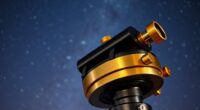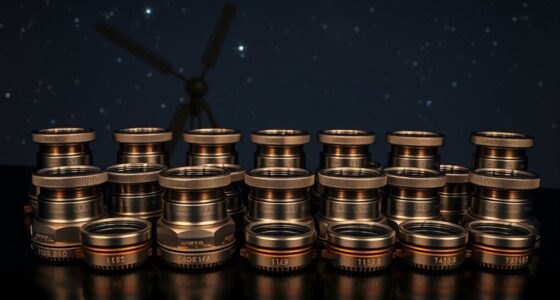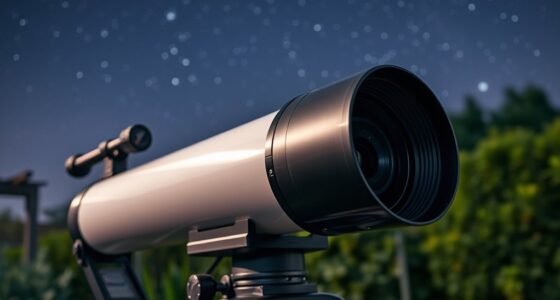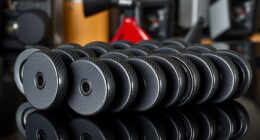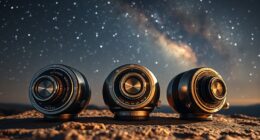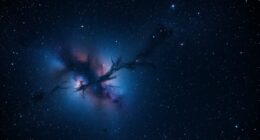If you’re after the best 2-inch duo band filters for crystal-clear imaging, I recommend exploring options like the Askar Colour Magic series, including models for H-alpha, OIII, and SII lines, which offer high transmittance and contrast. The Astromania narrowband filters are also excellent for capturing nebula details. These filters effectively cut light pollution and boost image clarity, making every shot sharper. Keep exploring, and you’ll discover the top choices to elevate your astrophotography game.
Key Takeaways
- High transmittance (>85%) across targeted spectral lines ensures bright, detailed images in various lighting conditions.
- Narrow bandwidths (around 6-8 nm) improve contrast by effectively blocking unwanted light and atmospheric interference.
- Durable build quality with resistant coatings guarantees long-term performance and artifact-free imaging.
- Dual-band capabilities allow simultaneous imaging of key emission lines like Hα, OIII, and SII for comprehensive celestial analysis.
- Designed for 2-inch mounts, these filters are compatible with most telescopes and cameras, supporting high-precision astrophotography.
Astromania Narrowband NBPF Hydrogen-a 12nm Filter

If you’re an amateur astrophotographer working in urban or light-polluted skies, the Astromania Narrowband NBPF Hydrogen-alpha 12nm Filter is a great choice. It enhances contrast by blocking stray light from mercury and sodium vapor lamps, making nebulae stand out even in Bortle 8 skies. With a 12 nm bandwidth centered at 656 nm, it transmits about 85% of H-alpha light, capturing hydrogen emission nebulae effectively. The filter threads directly into 2-inch eyepieces and is housed in a durable anodized casing. While some coatings may degrade over time, many users find it delivers impressive results for its price, especially with long exposures on modded cameras.
Best For: amateur astrophotographers working in light-polluted urban skies who want to capture hydrogen emission nebulae with enhanced contrast and detail.
Pros:
- Effectively blocks stray light from mercury and sodium vapor lamps, improving nebula contrast in light-polluted environments.
- High transmission of about 85% at the H-alpha line, enabling capture of faint hydrogen emission nebulae.
- Durable anodized casing and direct threading into 2-inch eyepieces make it easy to use and integrate with standard equipment.
Cons:
- Coating quality may degrade over time, leading to cracking or flaking in some cases.
- Slightly narrower FWHM and lower peak transmittance than specified, which could affect optimal performance.
- Less effective with unmodded DSLR cameras due to IR/UV filters requiring longer exposure times.
Askar Colour Magic C 2 Duo-Band Filter Set for Astrophotography

The Askar Colour Magic C 2 Duo-Band Filter Set stands out as an ideal choice for astrophotographers aiming to capture stunning nebulae even in light-polluted skies. This set includes C1 (Hα+OIII) and C2 (SII+OIII) filters, both with over 90% transmittance at key wavelengths, enhancing contrast and detail. They effectively block artificial light sources, darkening the sky background. These filters improve image sharpness and clarity, making nebulae more visible and easier to process. Compact and easy to use, they suit both beginners and experienced astronomers. Customers praise their performance, especially in urban environments, for producing high-contrast, detailed images.
Best For: amateur and professional astrophotographers seeking high-contrast nebula imaging in light-polluted environments.
Pros:
- High transmittance over 90% at key wavelengths (Hα, OIII, SII), enhancing image contrast and detail.
- Effectively reduces artificial light interference, suitable for urban and suburban skies.
- Compact, easy to install and use, making it accessible for beginners and experienced users alike.
Cons:
- Potential additional costs such as customs or import taxes for international buyers.
- Limited to specific emission lines, which may require complementary filters for broader spectral coverage.
- As with all narrowband filters, longer exposure times may still be necessary for optimal results in certain conditions.
Askar Colour Magic C2 Duo-Band Filter for Astrophotography

The Askar Colour Magic C2 Duo-Band Filter stands out as an excellent choice for astrophotographers working in urban or light-polluted areas, thanks to its ability to enhance contrast and reduce light interference. It transmits over 90% at key wavelengths (500.7nm and 672nm), effectively darkening the sky background and highlighting nebulae and gaseous structures. This filter blocks artificial lights like street lamps and city glow, making it easier to capture clear, detailed images. Its compatibility with one-shot color cameras and ease of use make it ideal for both beginners and experienced astrophotographers aiming for crisp, high-contrast celestial photography.
Best For: astrophotographers in urban or light-polluted areas seeking to improve contrast, detail, and clarity in nebula and gaseous structure imaging.
Pros:
- High transmission rate over 90% at key wavelengths (500.7nm and 672nm) for optimal performance.
- Effectively reduces light pollution from city lights and street lamps.
- Compatible with one-shot color cameras and easy to use for beginners and professionals alike.
Cons:
- Slightly heavier weight at 3.52 pounds, which may require sturdy mounting equipment.
- Limited to narrowband imaging, not suitable for broadband or wide-field astrophotography.
- Availability may be limited before the official release date of January 12, 2024.
Askar Colour Magic Super D2 Duo Narrowband Filter (OIII & SII)
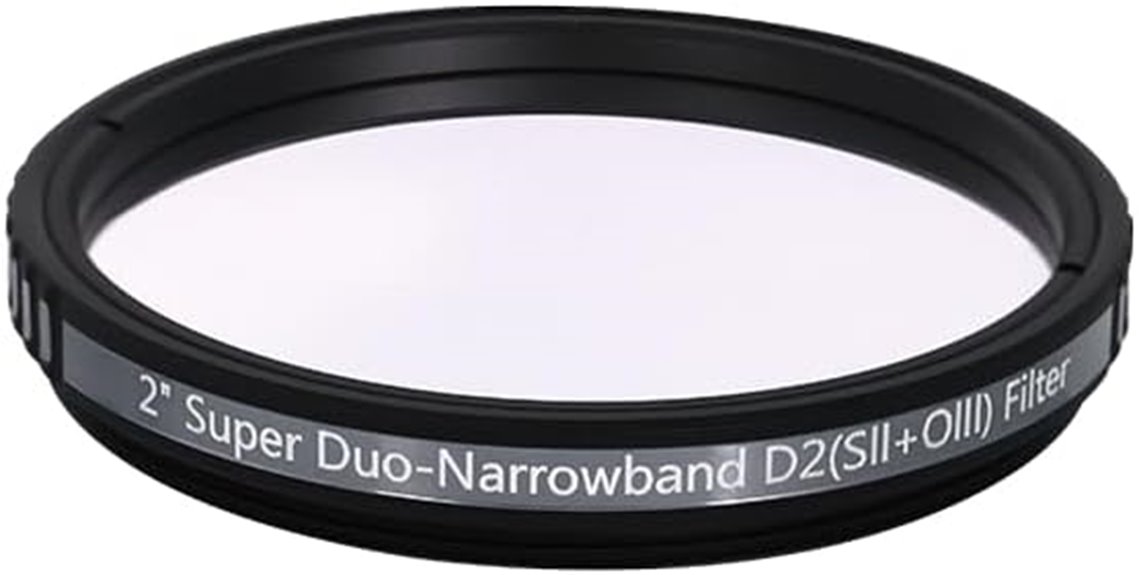
For astrophotographers seeking to capture stunning deep-sky images, the Askar Colour Magic Super D2 Duo Narrowband Filter (OIII & SII) stands out as an essential tool. This 2-inch filter boosts contrast and minimizes light pollution, making faint nebulae pop. With a peak transmittance of 85%, it effectively isolates OIII and SII emissions, with a narrow FWHM of 6.5nm and 8.5nm respectively. Its compact size and lightweight design make it versatile for various setups. First available in March 2024, it’s highly rated and backed by Askar’s support and warranty, offering a reliable choice for serious astrophotographers.
Best For: astrophotographers aiming to capture detailed deep-sky images with enhanced contrast and reduced light pollution.
Pros:
- Effectively isolates OIII and SII emissions with high peak transmittance of 85%
- Narrow FWHM of 6.5nm and 8.5nm enhances contrast for faint nebulae
- Compact, lightweight 2-inch design suitable for various astrophotography setups
Cons:
- Only filters for OIII and SII emissions, lacking H-alpha coverage
- Higher price point may be a consideration for budget-conscious users
- Limited to narrowband imaging, not suitable for broad-spectrum photography
Askar Colour Magic Super D1 Duo Narrowband Filter (OIII&Ha)

If you’re passionate about astrophotography and want to capture stunning emission lines, the Askar Colour Magic Super D1 Duo Narrowband Filter (OIII & Ha) is an excellent choice. This 2-inch filter enhances contrast by filtering out light pollution, making faint emission lines like OIII at 500.7nm and Ha at 656.6nm stand out. With a peak transmittance of 85%, it’s highly effective in Bortle 6 skies, delivering clearer, more detailed images. Its narrow bandwidth (6.5nm for OIII and 8.5nm for Ha) ensures precise targeting of emission lines, making it ideal for astrophotographers seeking crisp, vibrant captures of nebulae and other celestial objects.
Best For: astrophotographers and astronomy enthusiasts seeking to capture high-contrast, emission line-rich images of nebulae and celestial objects in light-polluted skies.
Pros:
- Enhances contrast and reduces light pollution for clearer astrophotography images.
- Narrow bandwidth filters precisely target emission lines at 500.7nm (OIII) and 656.6nm (Ha).
- Suitable for use in Bortle 6 skies, boosting visibility of faint celestial features.
Cons:
- Slightly heavy at 3.52 pounds, may require sturdy mounting equipment.
- Narrowband filters generally require longer exposure times for optimal results.
- Limited to 2-inch diameter, requires compatible telescopes and accessories.
Askar Colour Magic Ultra E2 Narrowband Duo-Band Filter (OIII+SII)
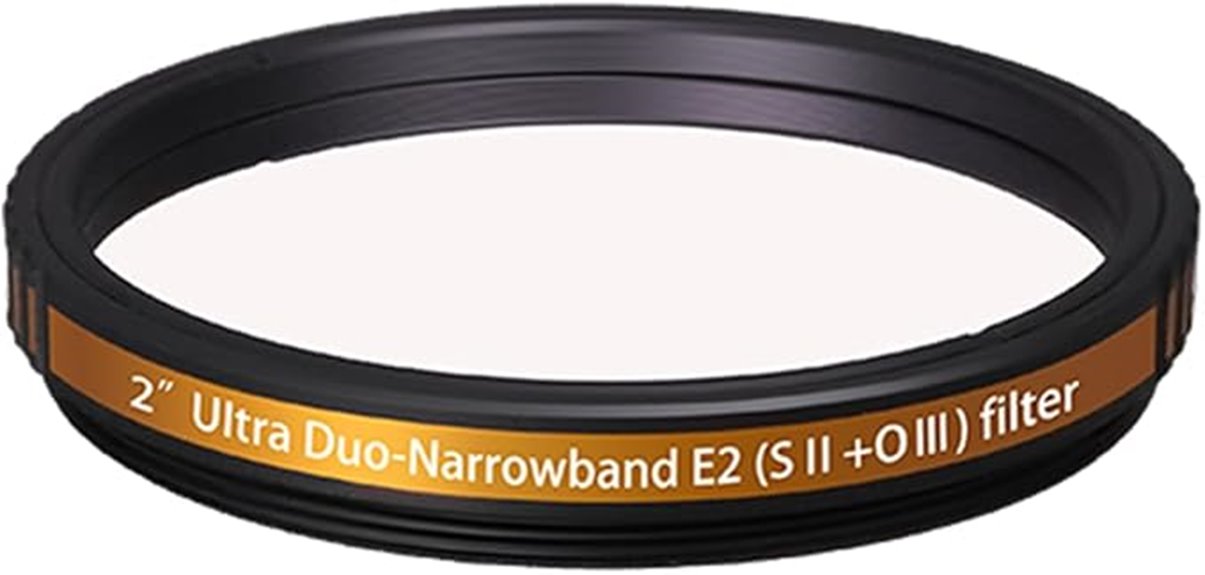
Astkar’s Colour Magic Ultra E2 Narrowband Duo-Band Filter (OIII+SII) stands out as an excellent choice for astrophotographers aiming to capture detailed nebulae in heavily light-polluted areas. Its duo-narrowband design enhances contrast by filtering out unwanted light pollution while highlighting nebula structures in OIII and SII wavelengths. With over 85% transmittance at key wavelengths, it guarantees bright, sharp images. The Ultra E2’s innovative halo control minimizes artifacts, delivering clearer detail. Compatible with both color and mono cameras, it’s perfect for deep-sky imaging, enabling high-contrast, detailed nebula observations even under challenging light conditions.
Best For: astrophotographers seeking to capture high-contrast, detailed nebula images in heavily light-polluted areas using both color and mono cameras.
Pros:
- Enhances contrast and detail by filtering out light pollution in OIII and SII bands
- High transmittance exceeding 85% ensures bright, sharp images
- Minimizes artifacts with innovative halo control for clearer nebula structures
Cons:
- Requires precise alignment and handling due to narrowband filtering
- Compatibility may depend on camera and telescope specifications
- Higher cost compared to standard broadband filters
1pc NEW 2 Duo-ban Dual Narrow Band Filter Light Damage Filter
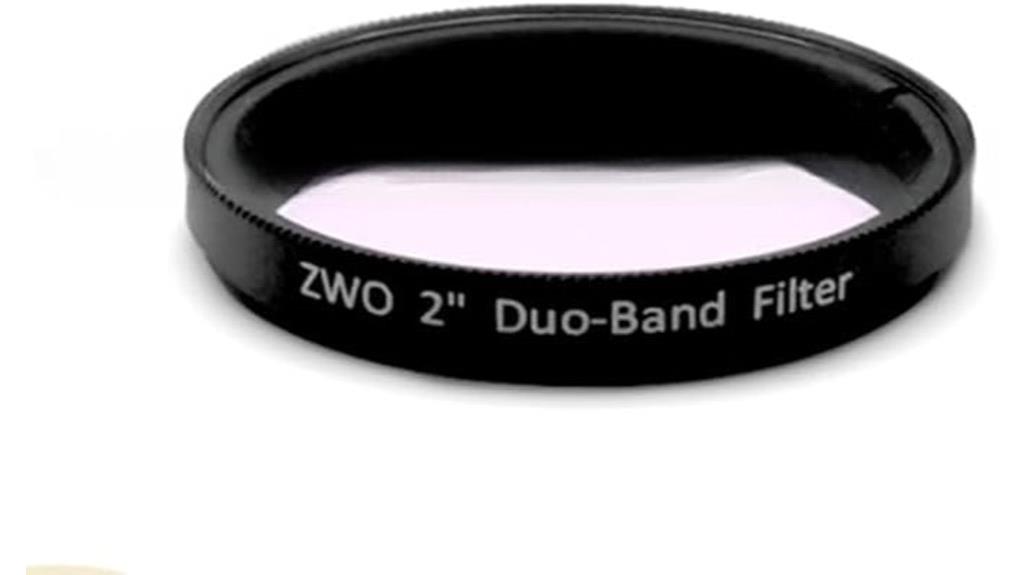
The pc NEW 2 Duo-ban Dual Narrow Band Filter Light Damage Filter is an excellent choice for astronomers and astrophotographers seeking reliable light damage protection without sacrificing filter quality. Manufactured by Yancinne, this single-unit filter offers high-quality narrow band performance, shielding your equipment from potential light damage during imaging sessions. Its dual-band design ensures precise wavelength filtering, enhancing image clarity. Available since October 11, 2024, it comes with a 120-day warranty and a 30-day return policy through Amazon. If you want peace of mind and superior protection for your gear, this filter is a smart addition to your astrophotography toolkit.
Best For: astronomers and astrophotographers seeking reliable light damage protection with high-quality narrow band filtering.
Pros:
- Provides effective light damage protection during imaging sessions
- Dual-band design enhances image clarity with precise wavelength filtering
- Comes with a 120-day warranty and a 30-day return policy for peace of mind
Cons:
- Only available as a single unit, limiting multi-filter setups
- May require compatible equipment and proper handling to maximize performance
- Limited information on additional features beyond light damage protection
Astromania 2-Inch Multi-Narrowband Galaxy and Nebula Telescope Filter
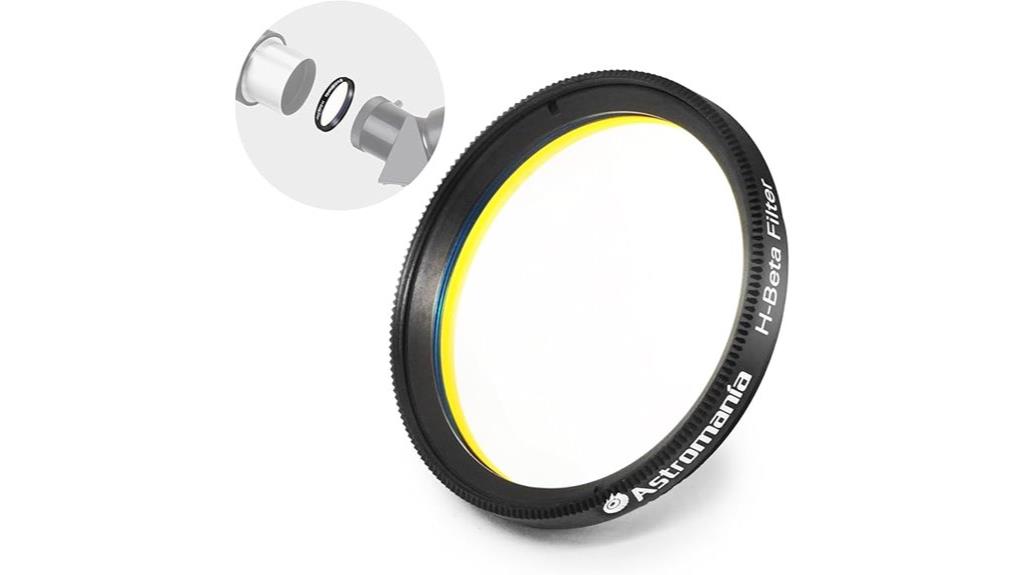
Looking for a filter that can sharply enhance your view of galaxies and nebulae while minimizing light pollution? The Astromania 2-Inch Multi-Narrowband Galaxy and Nebula Filter is exactly what you need. It offers over 90% light transmission, maintaining high contrast and sharpness without sacrificing brightness. Designed with a durable metal frame and versatile M48 and 2-inch threads, it’s easy to attach to most telescopes. This filter effectively blocks unwanted longer wavelengths and light pollution, revealing more detail in faint objects. Its polished substrate ensures optical precision, making it ideal for astronomers seeking clearer, more detailed celestial images.
Best For: Amateur and professional astronomers seeking high-contrast, detailed views of galaxies and nebulae with minimal light pollution interference.
Pros:
- Over 90% light transmission for bright, clear images
- Effectively blocks light pollution and longer wavelengths for improved detail
- Durable metal frame with versatile M48 and 2-inch threads for easy attachment
Cons:
- May require compatible telescope threading or adapters for some models
- Narrowband filters can reduce overall brightness of very faint objects
- Slightly more expensive compared to standard broadband filters
Astromania UHC Filter for Extended Nebulae

If you’re searching for a filter that markedly enhances faint nebulae visibility, the Astromania UHC Filter for Extended Nebulae is an excellent choice. It boosts contrast and blocks light pollution from mercury and sodium lamps, making faint objects like Orion, Lagoon, and Swan nebulae pop out clearly. Designed for both dark and light-polluted skies, it reveals details such as dust lanes and wisps with minimal brightness loss. The 2-inch filter is lightweight, individually inspected, and features inscribed transmittance percentages. Many users report improved views of nebulae and star-forming regions, especially in suburban areas, making it a versatile tool for visual astronomy.
Best For: amateur astronomers seeking to enhance visibility of faint nebulae and celestial details in both dark and light-polluted skies.
Pros:
- Significantly improves contrast and reveals faint nebulae like Orion, Lagoon, and Swan nebulae.
- Blocks light pollution from mercury and sodium-vapor lamps, suitable for suburban viewing.
- Lightweight, easy to attach with inscribed transmittance percentages, and comes with a sturdy case.
Cons:
- May cause slight color tinting, such as pink or purple hues, affecting natural colors.
- Less effective for lunar and galaxy observations, offering modest contrast improvements in those areas.
- Plastic housing requires careful handling to prevent damage, and some users find it relatively costly for the benefits.
Alstar Narrowband O-III Filter for Astronomy

For amateur astronomers seeking to enhance contrast in nebulae observation, the Alstar Narrowband O-III Filter is an excellent choice. Designed for 2-inch eyepieces, it’s made from high-grade glass with dichroic interference and anti-reflection coatings, reducing glare and ghosting. It specifically passes double ionized oxygen emission lines between 496 nm and 501 nm at 95% transmittance, blocking other wavelengths to boost nebulae contrast. This filter works well under all sky conditions, including light-polluted areas, revealing details in objects like the Veil, Ring, and Orion Nebula. Its quality inspection and inscribed transmittance guarantee reliable, clear views.
Best For: amateur astronomers seeking to enhance nebulae contrast and detail observation in both dark and light-polluted skies using a 2-inch eyepiece setup.
Pros:
- Enhances contrast and detail in emission nebulae such as the Veil, Ring, and Orion Nebula.
- Made from high-grade glass with dichroic interference and anti-reflection coatings to reduce glare and ghosting.
- Specifically passes double ionized oxygen emission lines at 95% transmittance, increasing nebulae visibility under various sky conditions.
Cons:
- Designed primarily for 2-inch eyepieces, may not be compatible with smaller or different size adapters.
- Narrowband filtering limits the viewing of objects outside the O-III emission lines, reducing versatility for general stargazing.
- Effectiveness is dependent on sky conditions; light pollution can still affect overall observation quality.
Astromania 2-inch Multi-Narrowband Galaxy and Nebula H-Beta Telescope Filter
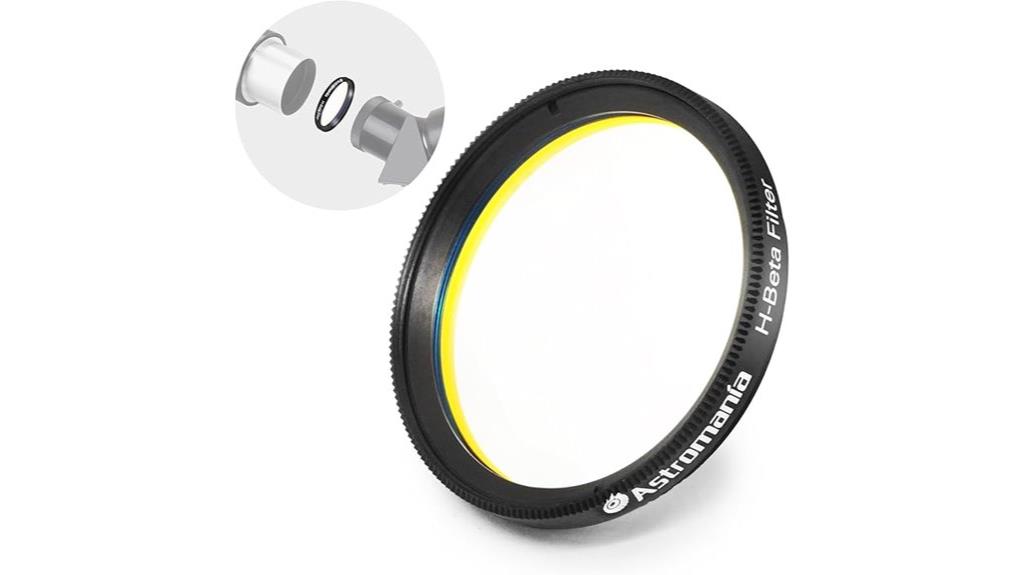
The Astromania 2-inch Multi-Narrowband Galaxy and Nebula H-Beta Telescope Filter stands out as an excellent choice for astronomers who want to enhance their views of faint celestial objects. With over 90% light transmission, it maintains sharpness and contrast while blocking light pollution and longer wavelengths. Its metal mount with 2-inch and M48 threads offers versatile attachment options. The filter’s fine-optically polished substrate and 0.25 wavefront accuracy guarantee high optical quality and clarity. Durable and reliable, it effectively reveals galaxy and nebula details, making it ideal for astrophotography and visual observation of deep-sky objects.
Best For: amateur and professional astronomers seeking high-quality, detailed views of galaxies and nebulae with minimal light pollution interference.
Pros:
- Over 90% light transmission ensures bright, clear images with high contrast.
- Versatile metal mount with 2-inch and M48 threads for easy attachment to various telescopes.
- High-quality optical construction with 0.25 wavefront accuracy provides sharp, detailed views.
Cons:
- May be more expensive than standard broadband filters due to specialized narrowband design.
- Requires proper handling to avoid scratches or damage to the polished substrate.
- Not suitable for general daytime use or observing objects outside of deep-sky astronomy.
Askar Colour Magic C 2 Duo-Band Filter Set for Astrophotography

Astrophotographers seeking high-contrast, detailed nebula images in light-polluted environments will find the Askar Colour Magic C 2 Duo-Band Filter Set to be an excellent choice. This set includes C1 (Hα + OIII) and C2 (SII + OIII) filters, both with over 90% transmittance at key wavelengths. They effectively block artificial light, darkening the sky background and highlighting nebulae’s emission lines. Compact and easy to use, these filters enhance image clarity and detail while reducing post-processing efforts. Perfect for both beginners and seasoned observers, they deliver clear, sharp images even under challenging light-polluted skies.
Best For: amateur and professional astrophotographers seeking high-contrast, detailed nebula imaging in light-polluted environments.
Pros:
- High transmittance over 90% at key emission lines for optimal image clarity.
- Effectively reduces light pollution, enhancing nebula contrast even from urban areas.
- Compact, easy to install and suitable for both visual observation and astrophotography.
Cons:
- Possible additional costs such as customs or import taxes despite product listings.
- Limited information on warranty and long-term durability from the manufacturer.
- Requires compatible telescope or camera setup to maximize filter benefits.
Askar Colour Magic C2 Duo-Band Filter for Astrophotography
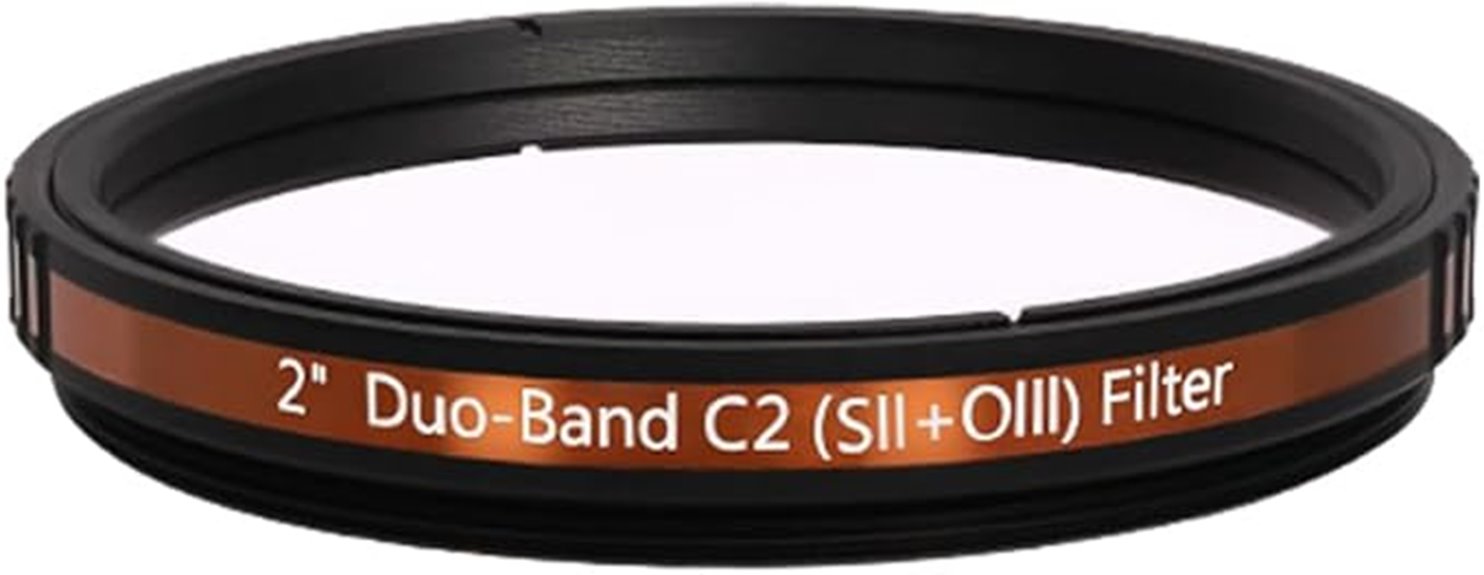
If you’re searching for a filter that effectively enhances nebula imaging in light-polluted areas, the Askar Colour Magic C2 Duo-Band Filter is an excellent choice. This 2-inch narrowband filter transmits over 90% at SII and OIII wavelengths, boosting contrast and highlighting nebula details while darkening the sky background. It reduces artificial light interference from city lights and street lamps, making it perfect for urban astrophotography. Easy to use with one-shot color cameras, it produces sharp, clear images with less post-processing. Customers rave about its high performance and affordability, making it a top choice for both beginners and experienced astrophotographers.
Best For: amateur and professional astrophotographers seeking to enhance nebula imaging in light-polluted urban environments.
Pros:
- Effectively transmits over 90% at SII and OIII wavelengths, improving contrast and detail.
- Reduces artificial light pollution, enabling clearer images in city settings.
- Easy to use with one-shot color cameras, producing sharp, clear images with less post-processing.
Cons:
- Limited to narrowband nebulae imaging; less effective for broad-spectrum astrophotography.
- Slightly heavier weight may require compatible mounting options.
- Only available in a 2-inch size, which may not fit all telescopes or camera setups.
Factors to Consider When Choosing a 2 Inch Duo Band Filter
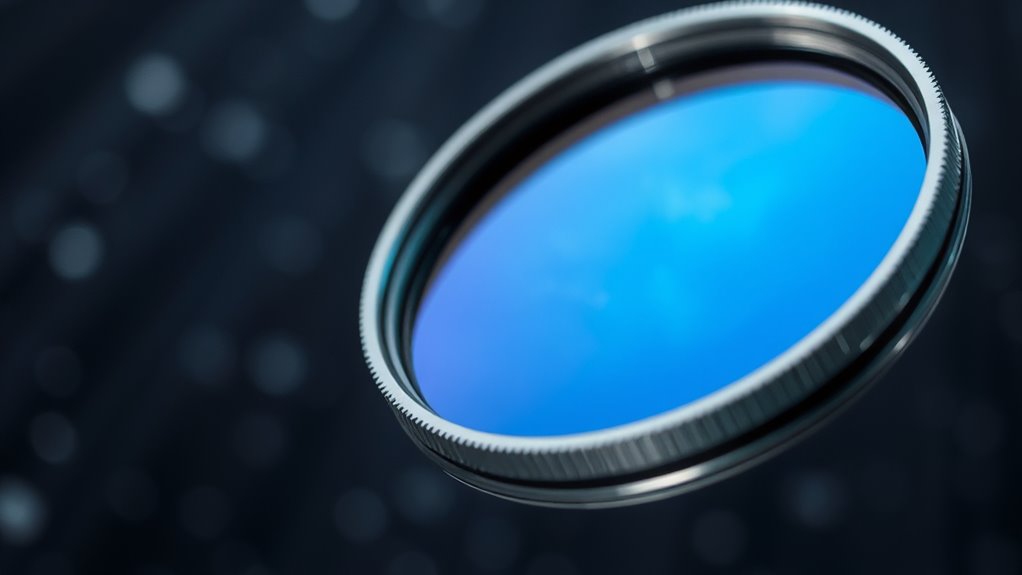
When selecting a 2-inch duo band filter, I consider factors like wavelength compatibility to guarantee it matches my target objects. I also look at bandwidth precision and light pollution rejection to improve image quality. Finally, I weigh build quality, durability, and price to find the best value for my investment.
Wavelength Compatibility
Choosing a 2-inch duo band filter requires careful attention to wavelength compatibility to guarantee it captures the right signals from celestial objects. I always check that the filter’s central wavelengths align with specific emission lines, like 656.3 nm for H-alpha or 500.7 nm for OIII, to target particular features. It’s also essential to verify that the filter’s bandwidth matches my observational goals; narrower bandwidths provide higher contrast but demand precise wavelength matching. I ensure the filter’s transmission peak fits within my camera’s spectral range to maximize light throughput. Additionally, I confirm that the filter’s wavelength ranges are compatible with my telescope’s coatings and accessories, preventing spectral mismatch. Proper wavelength compatibility ensures I capture sharp, detailed images of my celestial targets.
Bandwidth Precision
Precise control over a filter’s bandwidth is vital for capturing specific emission lines like H-alpha at 656.3 nm or OIII at 500.7 nm without unwanted spectral overlap. Narrow bandwidths, typically 3-6 nm, enhance contrast and detail by limiting extraneous light. The Full Width at Half Maximum (FWHM) measures how much of the spectrum the filter transmits at half its peak, directly impacting its accuracy. Slight differences, such as 8 nm versus 12 nm, can considerably affect the filter’s ability to isolate target lines from background light pollution. High-quality filters maintain consistent bandwidth across their entire surface, ensuring uniform spectral filtering. This precision is essential for achieving clear, detailed images and maximizing your telescope’s imaging potential.
Light Pollution Rejection
Effective light pollution rejection hinges on selecting filters with narrow bandwidths—typically around 6 to 12 nm—that target specific emission lines while blocking unwanted background light. These narrow bands guarantee that only the desired nebula signals pass through, minimizing interference from artificial lighting like streetlights and urban glow. High transmittance at these wavelengths, usually over 85%, allows for bright, clear images of nebulae even in light-polluted areas. Precise blocking outside the targeted lines—often less than 1% transmittance—further reduces moonlight and stray city lights, enhancing contrast. Multi-narrowband filters that combine lines like SII and OIII boost contrast and suppress light pollution more effectively. The filter’s optical coatings and construction also play a vital role in preventing glare and ghosting, ensuring peak light pollution rejection.
Build Quality & Durability
When selecting a 2-inch duo band filter, build quality and durability are essential to guarantee reliable performance over time. High-quality materials like precision-engineered metal housings and tough coatings ensure the filter resists environmental wear and tear. The threads and connections must be machined to tight tolerances, preventing cross-threading and ensuring a secure fit. Optical surface coatings should resist cracking, flaking, and fading, preserving image clarity. A robust construction minimizes internal reflections and ghosting, which can compromise image quality. Additionally, proper sealing and assembly protect the filter from dust, moisture, and temperature shifts, extending its lifespan in various observing conditions. Investing in a well-built filter guarantees consistent, high-quality performance for years of astrophotography.
Price & Value
Are you getting the best value for your money when choosing a 2-inch duo band filter? Higher-priced options typically offer better transmittance, narrower bandwidths, and more durable construction, making them ideal for serious astrophotographers. Cheaper filters often have wider bandwidths or lower transmittance, which can reduce contrast and image quality, diminishing overall value. Investing in a well-reviewed filter with high transmittance and durable coatings can save money long-term by reducing replacements or repairs. Some filters come with extra features like anti-reflection coatings or inspection reports, adding value regardless of price. Comparing the cost-to-performance ratio ensures you get the best scientific and optical benefits for your investment, helping you make a smarter, more satisfying purchase.
Frequently Asked Questions
How Do Duo-Band Filters Improve Astrophotography Quality?
Duo-band filters improve astrophotography by allowing me to capture two specific wavelengths simultaneously, which enhances contrast and detail. They reduce light pollution and atmospheric interference, making faint objects like nebulae and galaxies stand out more clearly. I love how these filters help me achieve sharper, more vibrant images by isolating essential light bands, giving my astrophotos a professional quality I couldn’t get with regular filters.
What Is the Optimal Size for 2-Inch Filters?
The ideal size for filters is 2 inches, which offers a great balance of compatibility and performance. I find that 2-inch filters fit most standard telescopes and cameras, making setup easier and ensuring wide coverage. They provide enough surface area to prevent vignetting and maintain high image quality. Plus, their size is manageable for handling and mounting, making them ideal for both amateur and professional astrophotography.
Can Duo-Band Filters Be Used With DSLR Cameras?
Sure, you can use duo-band filters with DSLR cameras, but don’t expect your camera’s tiny sensor to magically transform into a cosmic telescope. These filters are designed to fit standard 2-inch filter mounts, so you’ll need an adapter. Just remember, attaching a filter might slightly reduce light intake or introduce some reflections. So, while possible, be prepared for a bit of a technical dance to get perfect images.
How Do Narrowband Filters Affect Exposure Times?
Narrowband filters typically increase exposure times because they only let through a small portion of the light spectrum. This means I often need to extend my exposure by several times compared to unfiltered imaging to gather enough light for a clear photo. While it takes longer, I love the enhanced detail and contrast these filters provide, making the extra time well worth it for stunning, crystal-clear images.
Are There Compatibility Issues With Different Telescope Mounts?
The proof is in the pudding—compatibility can vary between telescope mounts. I’ve found that most 2-inch filters are designed to fit standard mounts, but it’s always wise to double-check thread sizes and mount specifications. Some specialized mounts might require adapters or specific filter holders. So, don’t assume universal compatibility; a quick review of your equipment’s specs can save you headaches down the line.
Conclusion
Choosing the right 2-inch duo band filter can truly elevate your astrophotography. Did you know that using narrowband filters can increase target contrast by up to 80%? That’s a game-changer for capturing stunning, detailed images of nebulae and galaxies. Remember, selecting the best filter depends on your specific needs and equipment. Invest wisely, and you’ll enjoy clearer, more vibrant cosmic shots that bring the universe closer than ever before.

